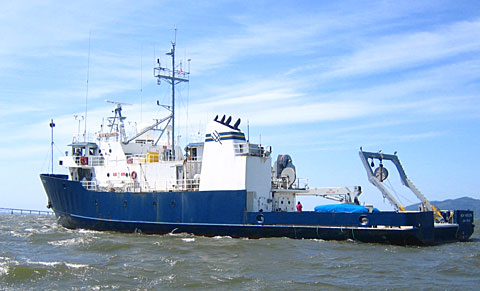You are here
R/V New Horizon Research Cruise - May 2009
 Date: May 12-30, 2009
Date: May 12-30, 2009
Chief Scientist: Byron Crump
Research Vessel: R/V New Horizon
Document: R/V New Horizon cruise plan (.doc)
CTD Sites:  View in Google Earth
View in Google Earth
Blog: Chief Scientist
SCIENTIFIC OBJECTIVES 
1. CTD casts and sensor-based measurements. We will occupy a grid of stations over the Oregon and Washington continental shelf and slope to measure hydrographic (T, S, pressure), bio-optical (chlorophyll fluorescence, light transmission) and chemical (nitrate, dissolved oxygen) parameters. Combine these data with ADCP measurements of subsurface velocity to explore biophysical interactions.
2. Water sampling. We will collect water samples for DNA- and RNA-based microbial community analyses, and measure bacterial production, primary production and water chemistry across environmental gradients in pelagic environments of the Columbia River, Estuary, Plume, and along established sampling lines on the Oregon and Washington coasts. Some sampling will be coordinated with the R/V Point Sur to sample the Estuarine Turbidity Maxima in the North and South Channels, and the Columbia River Plume. a. Chemical and biological measurements. Most samples will be analyzed for a suite of chemical and biological concentrations (nutrients, TDN/P, DOC, POC/N, SPM, Chl-a, HPLC pigments, cytometric cell counts, microscopic cell counts). Select samples will be analyzed for Colored Dissolved Organic Matter (CDOM) and dissolved CH4 (at eight sites along transect from outside CRmouth, into estuary and upriver to Beaver Army Dock (BAD)). b. Rate measurements. Most samples will be analyzed for bacterial production rate, and select samples will be analyzed for primary production rate and for biogeochemical rate processes (CH4 oxidation and NH4 oxidation). BP measurements will be conducted in an isotope van. Other measurements will be incubated in on-deck incubators.
3. Surface flow-through system. We will make continuous measurements of surface water chemistry with instrumentation attached to the continuous flow seawater system. These instruments will be ship-supplied fluorometer, flow meter, thermosalinograph, and oxygen sensor; and scientist-supplied fluorometer and flow-through cytometer.
4. Dye Studies. Conduct Dye studies to track water masses and use the SWAP system and model-based CORIE forecasts to help predict and follow coastal plume into which dye is released (coordinate with R/V Point Sur).
5. Plume Feature Tracking. Conduct Feature Tracking exercises using the SWAP system and model-based CORIE forecasts to identify sampling locations in the Columbia River Plume. Ship will cast CTD at pre-determined locations/times to test model.
6. SATURN station calibration. Provide ground truth measurements for the SATURN biogeochemical observatory system with 24-hour CTD and water sample studies near the stations and in nearby locations.
7. Estuary ETM sampling. Sample the Estuarine Turbidity maxima in the north and south channels of the estuary with a modified CTD attached to pump tubing that is paid out during each cast (coordinate with R/V Point Sur).




